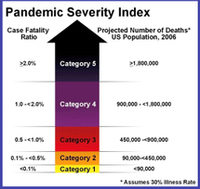
There is no technical reason why the Internet can’t handle the boom in traffic that might be expected in case of a plague.
Thanks to DWDM the Internet backbone has immense amounts of unused capacity. There is also competition, thanks to Level 3. If AT&T wanted to create an artificial shortage of supply in the Internet Core, in other words, they could not do it — competitors would just steal the customers.
Problems, if they exist, lie at the network edge. Cable Internet services are designed to share a designated hunk of bits within a neighborhood. When all the customers in an area go online at once, they get bits through an eyedropper. Telephone architecture is different. So long as there is ample local switching capacity, signals should flow easily between ADSL modems. (If you’re over 5 miles from a switch, you will have troubles, but you already have troubles.)
But there remains a political threat.
AT&T is already creating an artificial scarcity of bits. It doesn’t
sell the full bandwidth of its copper, keeping three-fourths of it for
an obsolete "voice" service. It doesn’t invest in its network. It
hoards wireless bandwidth — you can get more bits on the small slices
designated for WiFi than on all the licensed wireless networks out
there put together.
A "rush to the rail" by users stuck in their homes by the flu would
strain the present monopoly system, in places beyond its breaking
point.
But that’s not a technical problem. It’s a political problem. The
answer, as I’ve said here many times, is antitrust law. Break up the
Bells, increase the amount of unlicensed bandwidth available to device
makers, and the problem goes away almost immediately.
Those who believe in the Internet should not wait until the crisis is upon us to take action.












“Cable Internet services are designed to share a designated hunk of bits within a neighborhood. When all the customers in an area go online at once, they get bits through an eyedropper.”
This is an implementation issue not a technology issue. The fix is to just split each neighborhood into smaller zones. In the end the REAL bottleneck is how much bandwidth is given to the backhaul of each zone — just like with DSL. Meanwhile most cable companies only use 6 of 1000 available MHz for Internet, reserving the rest for TV. So, it is really pointless to try and draw a distinction between Big Cable and Big Telco in terms of business model or operational style.
“Cable Internet services are designed to share a designated hunk of bits within a neighborhood. When all the customers in an area go online at once, they get bits through an eyedropper.”
This is an implementation issue not a technology issue. The fix is to just split each neighborhood into smaller zones. In the end the REAL bottleneck is how much bandwidth is given to the backhaul of each zone — just like with DSL. Meanwhile most cable companies only use 6 of 1000 available MHz for Internet, reserving the rest for TV. So, it is really pointless to try and draw a distinction between Big Cable and Big Telco in terms of business model or operational style.